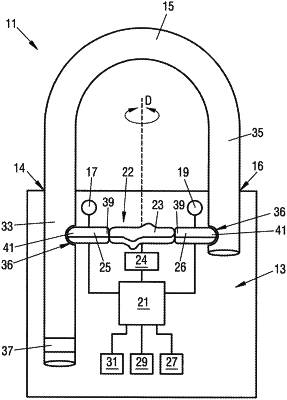| CPC E05B 47/0012 (2013.01) [E05B 45/06 (2013.01); E05B 67/063 (2013.01); E05B 67/22 (2013.01); E05B 2045/065 (2013.01); E05B 2047/0017 (2013.01); E05B 2047/0024 (2013.01); E05B 2047/0069 (2013.01)] | 19 Claims |

|
1. A portable electronic lock, comprising a lock body and at least one securing part,
wherein the at least one securing part can be selectively locked to the lock body or released from the lock body, and
wherein the lock body comprises:
a first introduction opening and a second introduction opening for introducing a respective section of the at least one securing part into the lock body;
an electromechanical locking device that has a first latch and a second latch, a cam rotatable about an axis of rotation, and an electric motor for driving the cam; and
a control circuit;
wherein the first latch can be displaced from an unlocked position into a locked position in which the first latch engages into the first introduction opening in order to lock the at least one securing part in the first introduction opening, and wherein the second latch can be displaced from an unlocked position into a locked position in which the second latch engages into the second introduction opening in order to lock the at least one securing part in the second introduction opening;
wherein the cam is configured,
in a first rotational position, to displace the first latch in the direction of the locked position and to release the second latch for a movement into the unlocked position;
in a second rotational position, to displace the second latch in the direction of the locked position and to release the first latch for a movement into the unlocked position;
in a third rotational position, to displace the first latch and the second latch in the direction of the locked position; and
in a fourth rotational position, to release the first latch and the second latch for a movement into the unlocked position; and
wherein the control circuit is configured to control the electric motor to selectively drive the cam into the first, the second, the third, or the fourth rotational position.
|